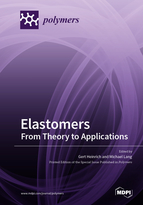Elastomers: From Theory to Applications
A special issue of Polymers (ISSN 2073-4360). This special issue belongs to the section "Polymer Applications".
Deadline for manuscript submissions: closed (25 October 2020) | Viewed by 42870
Special Issue Editors
2. Faculty of Mechanical Science and Engineering, Technische Universität Dresden, 01069 Dresden, Germany
Interests: polymer nanocomposites; friction and adhesion of polymer systems, wear; fracture mechanical characterization and modelling of crack formation and propagation in elastomers; statistical-mechanics of polymer networks, material laws, engineering applications; rubber elasticity and viscoelasticity of filled polymer networks; filler-polymer and filler-filler interactions in elastomers: modelling, testing, engineering applications; tire physics, mechanics and engineering (e.g. traction and braking, road-tire interactions), advanced tire materials compounding and testing
Special Issues, Collections and Topics in MDPI journals
Special Issue Information
Dear Colleagues,
This Special Issue focuses on the current state-of-the-art of elastomers, both in modern applications and from a theoretical perspective. The main characteristic of elastomer materials is the high elongation and (entropy) elasticity of these materials, and the ability to swell multiple times in a suitable solvent. The use of filled elastomers, especially of new kinds of elastomer nanocomposites, is of high interest for rubber technologies. Nanostructured adaptable gels allow tailoring of responsive materials or filtering systems. These materials enable widespread applications in engineering fields, ranging from modern tire technologies to medical applications and consumer goods. Elastomers also find utility in a range of biomaterial applications. Bioelastomers are widely available in nature, and have been shown to have specific properties often far superior to their synthetic counterparts. All elastomers share typical features, such as entropy-driven elasticity, the presence of entanglements, and topological constraints of network chain conformations. These features still offer fascinating scientific challenges in synthesis, characterization, and application, as well as for the theory of polymer networks and the modeling of elastomeric solids.
Papers are sought that discuss the latest research in the area or summarize selected areas in the field. The scope of the Special Issue encompasses frontier-of-science contributions in synthesis, characterization, modeling, and the theory of elastomers. Of particular interest are new structures and functionalities incorporated into elastomers, leading to enhanced properties of crosslinked elastomeric materials. Examples include conductive elastomers, mechanically adaptive elastomers, bioelastomers, photosensitive and light-controlled elastomers, elastomers with autonomous self-healing properties, and other novel elastomer-based materials.
Prof. Dr. Gert Heinrich
Dr. Michael Lang
Guest Editors
Manuscript Submission Information
Manuscripts should be submitted online at www.mdpi.com by registering and logging in to this website. Once you are registered, click here to go to the submission form. Manuscripts can be submitted until the deadline. All submissions that pass pre-check are peer-reviewed. Accepted papers will be published continuously in the journal (as soon as accepted) and will be listed together on the special issue website. Research articles, review articles as well as short communications are invited. For planned papers, a title and short abstract (about 100 words) can be sent to the Editorial Office for announcement on this website.
Submitted manuscripts should not have been published previously, nor be under consideration for publication elsewhere (except conference proceedings papers). All manuscripts are thoroughly refereed through a single-blind peer-review process. A guide for authors and other relevant information for submission of manuscripts is available on the Instructions for Authors page. Polymers is an international peer-reviewed open access semimonthly journal published by MDPI.
Please visit the Instructions for Authors page before submitting a manuscript. The Article Processing Charge (APC) for publication in this open access journal is 2700 CHF (Swiss Francs). Submitted papers should be well formatted and use good English. Authors may use MDPI's English editing service prior to publication or during author revisions.
Keywords
- elastomer nanocomposites
- conductive elastomers
- bioelastomers
- light-controllable elastomers
- elastomers with self-healing properties
- smart and adaptive elastomers
- elastomers for future tire technologies
- advanced modeling and simulation of elastomers
- cutting-edge characterization of elastomers
- theory of rubber elasticity
- elastomers with novel network structure
- nanostructured amphiphilic gels







